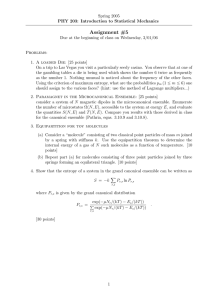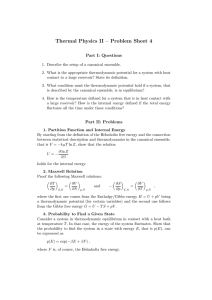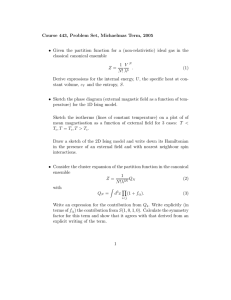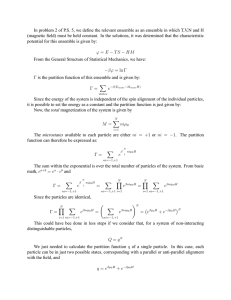Recitation: 10/30/03
advertisement
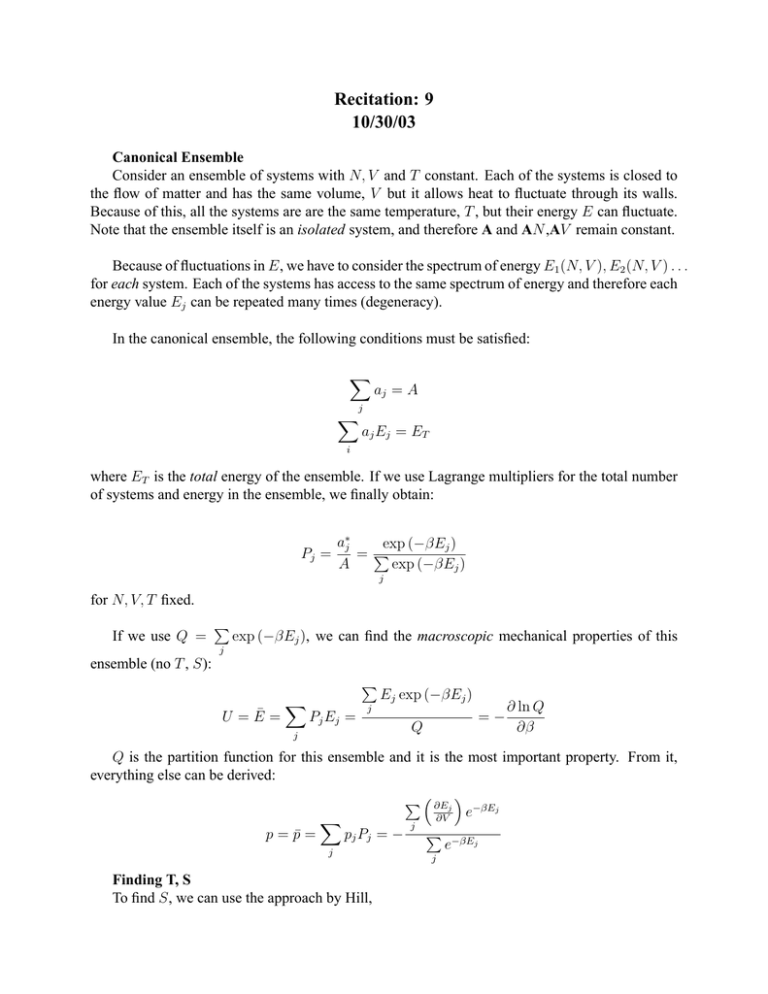
Recitation: 9 10/30/03 Canonical Ensemble Consider an ensemble of systems with N, V and T constant. Each of the systems is closed to the flow of matter and has the same volume, V but it allows heat to fluctuate through its walls. Because of this, all the systems are are the same temperature, T , but their energy E can fluctuate. Note that the ensemble itself is an isolated system, and therefore A and AN ,AV remain constant. Because of fluctuations in E, we have to consider the spectrum of energy E1 (N, V ), E2 (N, V ) . . . for each system. Each of the systems has access to the same spectrum of energy and therefore each energy value Ej can be repeated many times (degeneracy). In the canonical ensemble, the following conditions must be satisfied: � aj = A j � aj Ej = ET i where ET is the total energy of the ensemble. If we use Lagrange multipliers for the total number of systems and energy in the ensemble, we finally obtain: a∗j exp (−βEj ) Pj = =� A exp (−βEj ) j for N, V, T fixed. If we use Q = � exp (−βEj ), we can find the macroscopic mechanical properties of this j ensemble (no T , S): � � U = E¯ = Pj Ej = Ej exp (−βEj ) j j = − Q ∂ ln Q ∂β Q is the partition function for this ensemble and it is the most important property. From it, everything else can be derived: � � ∂Ej � −βEj e ∂V � j � −βE p = p̄ = pj Pj = − j e j j Finding T, S To find S, we can use the approach by Hill, We can take the differential of E = � j dE¯ = Ej Pj : � Ej dPj + Pj dEj (1) j From: e−βEj e−βEj Pj = � −βEj = Q e j We obtain 1 Ej = − (ln Pj + ln Q) β Substituting in Eq. 1, we have: 1 dE¯ = − β � (ln Pj + ln Q) dPj + � j � Pj j ∂Ej ∂V � dV N Note that Ej are only function of N and V . Using the properties of Pj : � Pj = 1 j � d � � j � Pj ln Pj = � Pj j dPj = 0 � � 1 dPj + ln Pj dPj = ln Pj dPj Pj j j we have: 1 − d (Pj ln Pj ) = dE¯ + pdV ¯ β From Thermodynamics, we know that T dS = dU + pdV And we therefore can establish the following relations: U ↔ E¯ ↔ p̄ p 1 T dS ↔ − β d (Pj ln Pj ) We finally have: S = −k � Pj ln Pj j If we substitute the expression for Pj : � � e−βEj � 1 � −βE − Ej − ln Q S = −k j kT e j j S= Ē U F + k ln Q = − T T T F is the Helmholtz free energy and is the characteristic potential for systems with N , V and T as independent variables. Note that these are the same boundary conditions stated for the Canoni­ cal ensemble. Once we have F (N, V, T ) = −kT lnQ(N, V, T ), we can define all the thermodynamic proper­ ties related to this potential: dF = −SdT − P dV + � µi dni i � � � � ∂F ∂ ln Q = kT + k ln Q S=− ∂T V,N ∂T V,N � � � � ∂F ∂ ln Q p=− = kT ∂V T,N ∂V T,N � � � � ∂F ∂ ln Q µ= = −kT ∂ni T,V,ni=j ∂ni T,V,ni=j � �� � � � F ∂T ∂ ln Q U = E = −T 2 = kT 2 ∂T ∂T V,N The last expression comes from: � U = F + TS = F − T ∂F ∂T � � = V,N ∂ FT ∂ T1 � If you have the partition function Q you can obtain every thermodynamic property of a system. General Structure for any set of Boundary Conditions For any set of boundary conditions, the probability for the system to be in any microstate ν is given by: e�v Pν = � �η e η The partition function, for this probability distribution, is given by: Z= � e�η η Each ensemble has its characteristic function, Λ: 1 Λ = − ln Z β For any set of thermodynamic boundary conditions, the main problem is to find �. This can be done using the following procedure: i) Write down the Euler relation in the entropy representation and divide by k: S = βE + βP V − βµN + . . . k ii) Identify the independent variables in the ensemble. These variables are the Thermodynamic Boundary Conditions. For the canonical ensemble, the independent variables are (T, V, N ) iii) Compare the boundary conditions to the natural variables for the entropy S (E, V, N ). iv) Legendre transform the Euler expression in the entropy representation, with respect to the independent intensive variables that appear in the ensemble. For the Canonical Ensemble, we have: S Φ = − βE k v) � is given by: S �=Φ− k For the Canonical Ensemble, we have: S � = Φ − = −βE k vi) The characteristic function Λ is: 1 Λ=− Φ β For the Canonical Ensemble we have: Λ = F = E − TS vii) Using the general structure for Stat Mech we have, for the Canonical Ensemble: e−βEv Pν = � −βEη e η Z=Q= � e−βEη η S −βF = − βE = ln Q k It is possible to expand both sides of the equation F = −kT lnQ with Q= � e−βEi i If we expand both sides of this equation, we apparently obtain: F = E − TS = E According to the expression above, the T S term has disappeared!! To resolve this discrepancy, remember that the summation in Q is over all the microstates available to the system and not over the energy levels. Each energy level is highly degenerate, and Q can be expressed as: � Ω (N, V, E) e−βEE levels Q= E levels Now, we can perform the expansion: F = E − T S = E − kT ln � Ω (N, V, E) E levels By inspection, it can be seen that � S=k lnΩ (N, V, E) E levels This expression is the classical expression for the entropy of an isolated system (microcanoni­ cal ensemble). Note that the Canonical ensemble is basically a collection of microcanonical ensembles. In general, we can write down the partition function for any ensemble as: � Z= Ω (N, V, E) e−βX1 e−βX2 X1 ,X2 ... In this general expression, the degeneracy of each energy level has been taken into account by Ω (N, V, E). The sum in this case is not over all the microstates but over the different values that the extensive properties (such as energy, volume, N, magnetization, etc. can take). For more details, see Hill, p. 30 Example: Ensemble with N, P and T as independent variables: 1. Euler Relation: S = βE + βP V − βµN k 2. The independent variables are (T, P, N ) 3. We need to do the Legendre Transform: Φ= S − βE − βP V k 4. By inspection, G=− Φ β 5. Using the general structure, we finally have: e−βEv −βpVν Pν = � −βEη −βpVη e η Z= � e−βEη −βpVη η −βG = S − βE − βpV − βµN = ln Z k Once you have the partition function and you have identified the characteristic function, every­ thing else can be readily obtained: From Classical Thermodynamics, we have: dG = −SdT + V dP + µdN And therefore, � � � � � � ∂G ∂kT ln Z ∂ ln Z kT ∂Z S=− =+ = kT + k ln Z = + k ln Z ∂T P,N ∂T ∂T P,N Z ∂T P,N � � � � ∂G ∂ ln Z V = = −kT ∂P T,N ∂P T,N � � � � ∂G ∂ ln Z µ= = −kT ∂N T,P ∂N T,P Problem 1 Lagrange Multipliers: N N � � Show that − Pj ln Pj , subject to the condition Pj = 1 is a maximum when Pj is a con­ j=1 j=1 stant. Solution 1 Here we use Lagrange multipliers again with the constraint M = − N � � Pj ln Pj − α N � j=1 � � Pj − 1 j=1 Maximize � ∂M ∂Pj � = − ln Pj − 1 − α = 0 Pj = exp [− (1 + α)] Determine α N � Pj = N exp [− (1 + α)] = 1 j=1 exp [− (1 + α)] = Thus Pj = 1 N 1 N Pj = 1. j Problem 2 The partition function of a monatomic ideal gas is: 1 Q (N, V, T ) = N! � 2πmkT h2 �3N/ 2 VN Derive an expression for the pressure and the energy from this partition function. Solution 2 For p, � � ∂ ln Q p = kT ∂V T.N � � � � 1 3N 2πmkT ln Q = ln + ln + N ln V N! 2 h2 p= kT N V For E � E = kT 2 ∂ ln Q ∂T � � = kT 2 N,V E= 3N kT 2 3N 2 2πmk h2 2πmkT h2 �
